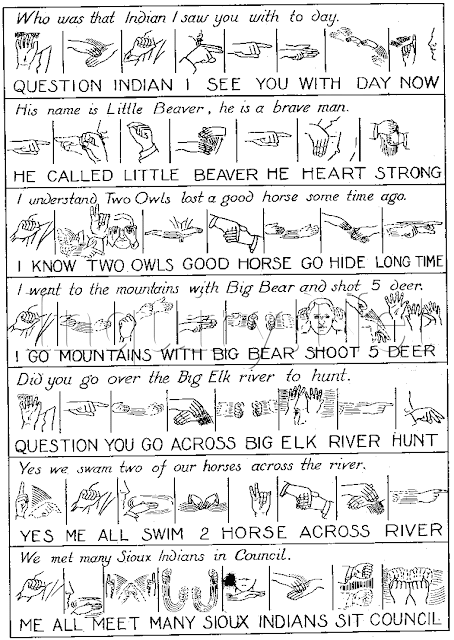I've been reading The Journals of Lewis Clark - an abridged version edited by the noted scholar Bernard DeVoto in the early Fifties - and I came across a rather interesting passage. In December of 1804 the expedition was camped for the winter at Fort Mandan and living among the Mandan indians of the upper Missouri river in the area we know today as North Dakota. Probably not the warmest place to hunker down for winter, but still much safer than forging forward into unknown territory at the onset of a generally brutal season. And really, there was some good company to be had: besides the amenable Mandans, the area was frequently traversed by Canadian trappers and traders - it was here that the expedition took on Sacagawea and her Quebec-born husband, Touissant Charbonneau - and then there were others as well...
On December 22nd, Clark - who writes in a funkier, more archaic style than that of his partner, Lewis - records in his journal (parentheticals my own):
"worm (warm). a number of Squars (squaws) & men Dressed in Squars Clothes Came with Corn to Sell to the men for little things, We precured two horns of the animale the french Call the rock Mountain Sheep."
Hello! Trannies of the old West! And these girls want the goods, too. Though there is no indication what exactly they walked away with after the trade, at the time the party was carrying a heavy load of trade goods - for diplomatic presentations to tribal chiefs along the way and also, especially, to exchange for food, horses, and other supplies as needed. These goods included tobacco, buttons, fishing hooks, woven apparel, handkerchiefs, ribbons, and especially beads, which apparently were universally well-received by the natives.
DeVoto also adds an explanatory footnote to the passage, surprisingly balanced I think for the early 1950's: "These are 'berdashes,' that is, homosexuals; the Indians believed that they had been directed by a medicine vision to dress and act as women and they suffered no loss of status." And I should think at the time that visionary drag queens were in sorely short supply East of the Mississippi.
"Dance to the Berdache" by George Catlin (1796-1872)
The designation berdache actually does not have its origins in any indigenous American language, but rather it was a moniker hung on the social type by Europeans who didn't have the conceptual tools to fully apprehend the matter-of-factness and level of social integration of these people within their communities. It's actually in root a pejorative term, and in fact the Europeans and Americans pretty much succeeded in wiping them out - or it out, I should say, as a cultural behavior - in the subsequent years of relentless Christian missionary work and otherwise "Anglicizing" educational efforts.
The berdache was a pretty interesting figure in Native American society, and not because they were simply "gay" (to rely upon a very modern construct) or even cross-dressers. The berdaches were actually considered "two-spirited" - a unity of the male and the female constituting a "third gender"; and in fact they occupied elevated and respected positions in tribal society. And this was pretty universal, from the Mandan peoples of North Dakota to the Pueblo cultures of the Southwest. Wikipedia reports that instances of berdachism have been documented from over 130 tribes across the continent.
Will Roscoe, one of the pre-eminent American scholars of the phenomenon, is the author of The Zuni Man-Woman (University of New Mexico Press, 1991), a biography and consideration of We'wha - a berdache who actually traveled to Washington D.C. in 1886 as a cultural ambassador representing the Zuni nation! Roscoe writes of berdachism as a "socially approved channel for the expression of a pattern of sex and gender variance that allowed individuals to make unique social, religious, and artistic contributions to their communities." And both the level of contribution and reciprocal respect for it was apparently quite high.
It would be very easy to spend a lot of time sharing Roscoe's work - it is definitely fascinating material - but I don't want to stray too far away from the Lewis and Clark narrative. Not yet anyway. Mostly here I am citing his work as a means of giving the Journals passage a broader context. I will, though, include this differentiation he makes between the berdache and the shaman, taken from a supplementary interview, that fleshes out the role of the berdache a bit more:
Berdaches and shamans are different, and it's very important at this point to draw out this distinction. Shamans classically belong to small tribal societies, although not exclusively. They are involved in ecstatic experiences and contact with the otherworld and they work very much on their own. The shaman is extremely liminal and ambivalent morally and socially. The berdache is a social, collective figure - a specialist, a cultural worker, a priest, an artist. A berdache is a person who mediates the divisions and contradictions within the community, as opposed to the shaman, who works with the outside.
These are very important traditions. We know all about the shaman because he appeals to Western, individualistic, heroic patterns. We don't know about the berdache because they wore dresses; their history has been suppressed and their voices squelched. Even gay people today feel ambivalent about the berdache. But to me the berdache figure is one for us to look toward as gay people. They did magics of healing, meditation, and unification. They could foretell the future and predict the weather. And you didn't ever want to get one mad at you because their curses had an uncanny way of coming true. *Well I think the same rules hold true today: you simply don't want to piss off the drag queens.
* Quote is taken from an interview between Will Roscoe and Mark Thompson, in Gay Soul: Finding the Heart of Gay Spirit and Nature with Sixteen Writers, Healers, Teachers, and Visionaries, 1994.









